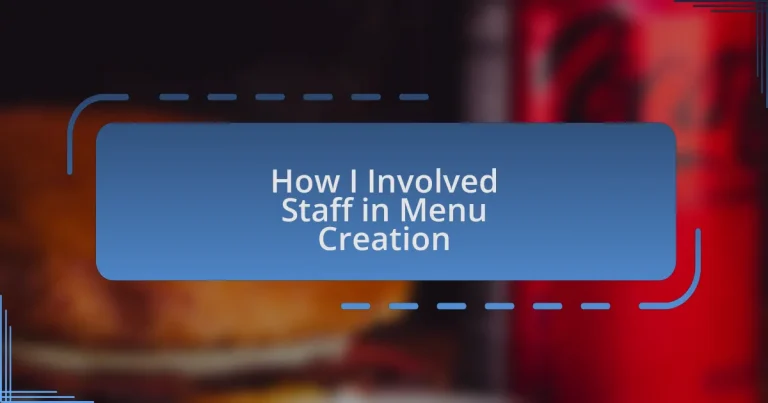Key takeaways:
- Engaging staff in the menu creation process fosters ownership, enhances creativity, and improves customer experiences.
- Collaborative menu design brings diverse perspectives, transforming simple ideas into customer favorites.
- Implementing staff suggestions promptly and celebrating their contributions promotes a culture of appreciation and motivation.
- Evaluating menu success involves collective insights and feedback, reinforcing team ownership and pride in their contributions.
Author: Olivia Hartwell
Bio: Olivia Hartwell is a contemporary fiction author known for her compelling narratives and vivid characterizations. With a background in literature and creative writing, she has a keen eye for detail and a passion for exploring the complexities of human relationships. Olivia’s debut novel, Whispers of the Heart, received critical acclaim and was nominated for several literary awards. When she’s not writing, she enjoys hiking in the mountains of Colorado and sipping artisanal coffee at local cafes. Olivia resides in Denver with her beloved rescue dog, Rosie.
Introduction to Menu Creation
Creating a menu is more than just listing items; it’s about weaving experiences that resonate with both the staff and customers. I remember the excitement in the air when I first gathered my team for a brainstorming session. It was thrilling to see their passion and creativity unfold as we delved into what makes a burger not just food, but a memory.
The collaborative process not only cultivates a sense of ownership among staff but also brings fresh perspectives to the table. Have you ever wondered how a simple ingredient can transform a dish? I’ve seen how one team member suggested adding a unique sauce, and it quickly became a customer favorite, proving that everyone’s input matters.
Menu creation is an evolving journey that reflects the tastes and dreams of the entire team. Each dish is a story, and I often think about the joy it brings when our ideas not only feed bellies but also spark conversations. By involving staff in this journey, we’re not just preparing meals; we’re crafting an experience that delights and inspires.
Importance of Staff Involvement
Engaging staff in the menu creation process is vital because it fosters a profound sense of ownership. I vividly recall a moment when a shy team member proposed a vegetarian option after hearing customer feedback. That idea sparked not just a new dish, but a realization that our menu truly reflects our community’s tastes. Don’t you think it’s empowering for staff to see their contributions come to life?
Involving staff also brings diverse perspectives that enhance creativity. I remember a spirited debate over which toppings should accompany our signature burger. By encouraging everyone to share their opinions, we didn’t just arrive at a consensus; we built camaraderie. Isn’t it fascinating how these conversations can lead to innovative combinations that surprise and delight customers?
Moreover, when employees feel valued in decision-making, it translates to a positive dining experience for customers. I’ve noticed that our team’s enthusiasm resonates with patrons, creating a welcoming atmosphere. Have you ever walked into a restaurant and felt the energy from the staff? That’s the magic of involvement, and it keeps customers coming back for more.
Benefits of Collaborative Menu Design
Collaborative menu design yields a wealth of ideas that might otherwise go unnoticed. For instance, during one brainstorming session, a quiet team member shared a unique sauce recipe inspired by their grandmother’s cooking. This not only added a personal touch to our offerings but also made the team feel valued—it’s incredible how a simple idea can spark excitement and connection. Have you ever tasted something that reminded you of home?
When staff members contribute to the menu, it creates a stronger team dynamic. I once had a cook suggest a fusion dish that combined flavors from his family’s heritage. Watching everyone rally around his idea and work together to create something delicious was a transformative experience. It’s empowering to see how collaboration fosters trust and mutual respect among colleagues, don’t you think?
The impact goes beyond the menu; it enhances the overall customer experience. I remember a feedback session where we discovered patrons loved the stories behind each dish. Each time we share a staff-inspired creation, we’re not just serving food; we’re sharing a narrative that draws customers in. Isn’t it rewarding to connect on that level?
Steps for Engaging Staff
One effective step for engaging staff in menu creation is to hold regular brainstorming sessions. I’ve seen how inviting everyone to contribute ideas can lead to unexpected gems. For example, one day, a team member suggested using a local cheese supplier for our burgers, and we ended up creating a mouthwatering dish that became a customer favorite. It’s amazing how a casual discussion can ignite enthusiasm and creativity.
Another powerful tactic is to create a feedback loop where staff can see the impact of their suggestions. After implementing a new item on the menu based on a line cook’s idea, I made it a point to share customer reactions and feedback with the entire team. The sense of pride and ownership that blossomed from knowing their contributions made a real difference was palpable. Do your team members see how their ideas shape what you serve?
Lastly, celebrating small successes boosts morale and encourages further participation. I once organized a “Dish of the Month” contest where staff could submit their creations. We celebrated the winner at our next team meeting, turning the spotlight on their achievement. It fostered a sense of camaraderie and inspired others to think creatively, wouldn’t you agree that recognition fuels further innovation?
Techniques for Collecting Ideas
One technique I found effective is using suggestion boxes placed in the staff area. I remember when we first tried this, it was met with some skepticism. However, after giving it time, the influx of creative ideas shocked us all. It was fascinating to see how staff members felt more comfortable sharing their thoughts anonymously, leading to innovative ideas I hadn’t even considered before. Have you ever wondered what gems might be hidden in your team’s mind if only they had a safe space to express them?
Additionally, I’ve experimented with themed idea-generation sessions that align with specific events or holidays. For instance, during the summer, we held a “BBQ Bonanza” brainstorming session. The energy was electric as the team bounced ideas off one another, leading us to create a limited-time menu that not only attracted new customers but also revitalized our current offerings. Can you feel how the excitement of a focused theme can spark creativity and connection among staff?
Finally, I developed an idea rotation schedule, where each team member would take turns sharing a dish concept at our weekly meetings. This approach not only democratizes the idea generation process but also gives everyone ownership of the menu’s evolution. I still remember the thrill on one team member’s face when their concept was chosen for the next month’s featured burger. Doesn’t it make sense that empowering everyone to present their ideas in a structured manner fosters a greater sense of belonging and responsibility?
Implementing Staff Suggestions
When it comes to implementing staff suggestions, I’ve found that acting on these ideas promptly is crucial. For example, one summer, a team member proposed a “Tropical Twist” burger with pineapple and teriyaki sauce. We decided to put it on the menu almost immediately, and the customers’ positive response was overwhelming. Isn’t it exciting to see how quickly a suggestion can transform into a customer favorite?
Moreover, after integrating suggestions, I make it a point to gather feedback from the team about the changes. Last fall, we rolled out a salad inspired by a staff member’s idea, and I encouraged them to monitor its performance and customer reactions closely. The look of pride on their face when they heard positive feedback reinforced the value of their input. How often do we overlook the joy in seeing our contributions make a difference?
Lastly, sharing the success of implemented suggestions creates a culture of appreciation and motivation. When we celebrated the popularity of a burger based on a staff idea during our team meeting, the atmosphere was electric. It’s moments like these that remind me how vital it is to acknowledge their creativity and inclusion in our journey. Isn’t it empowering to know how much of an impact one voice can make?
Evaluating Menu Success Together
Evaluating the success of our menu is not just about analyzing sales; it’s a collective effort that involves the entire team. After introducing new items, I often gather the staff for a roundtable discussion, where we share insights on customer preferences and the dishes’ performances. Recently, when we reviewed a spicy burger that a team member championed, I could see their excitement as they shared how customers reacted. Isn’t it inspiring to witness how our collaborative efforts translate to tangible success?
I’ve also learned that creating a feedback loop is essential. After every menu cycle, I circulate a simple survey among the staff, asking them not just for numbers but for their personal reflections on each item. This approach led to a fascinating revelation about a seemingly unpopular dish; one of the cooks shared that some patrons loved it as a unique late-night snack. It’s moments like these that make me question: What hidden gems might we discover if we just listen to each other a little more?
Celebrating our findings together fosters a sense of ownership and pride. At our last staff meeting, we highlighted the top-selling items, and you could feel the enthusiasm in the air. When team members realized that their contributions helped shape our bestsellers, the energy was contagious. Isn’t that what every workplace strives for—a sense of shared success?


